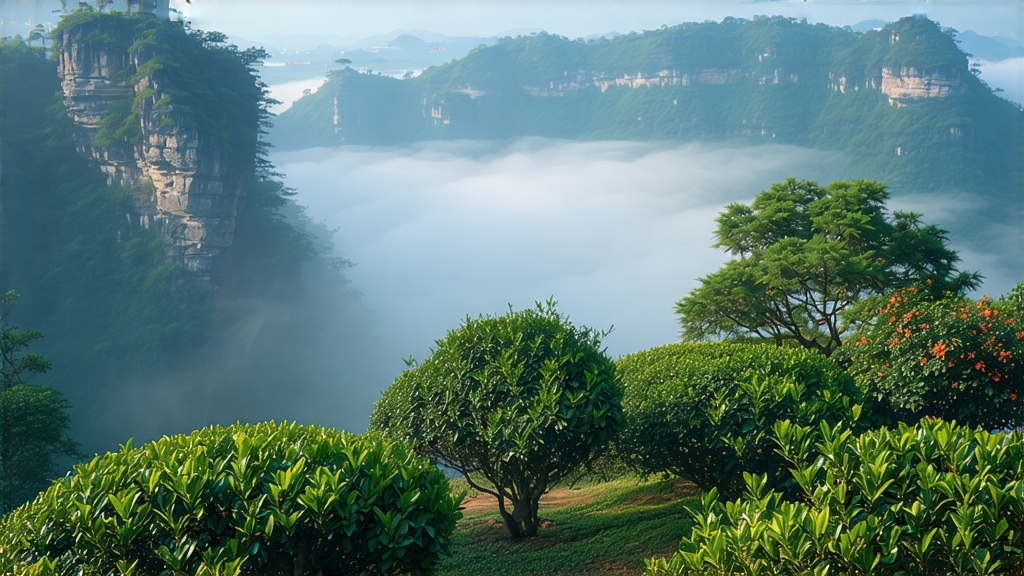
High above the winding Jiuqu Stream, where the Wuyi Range thrusts its granite ribs into the humid Fujian sky, grows the most mythologized oolong on earth—Da Hong Pao, literally “Big Red Robe.” To understand this tea is to listen to a 350-year-old aria sung by stone, fire, and mist; to taste it is to sip the very mineral marrow of China’s southeast. International catalogs often lump it under the generic label “Wuyi rock oolong,” yet Da Hong Pao is not a single garden or cultivar but a micro-universe of lineages, processing styles, and terroir expressions that reward the patient explorer with layers of “rock rhyme”—the untranslatable yan yun that connoisseurs swear can echo in the throat for hours.
Historical scrolls kept by the Wuyi Monastery credit a Ming-dynasty scholar named Ding Xian with the first act of homage. Having paused at the Tianxin Rock on his way to the capital examinations, he was revived by a brew offered by monks; upon earning the highest jinshi degree he returned in crimson official robes and draped them over the six mother bushes as thanks. Whether apocryphal or not, the story anchored the tea in imperial imagination. By the Qing Qianlong era (1736–1795) Da Hong Pao was already listed among the “tribute teas” dispatched to Beijing in quantities so small that court physicians prescribed it drop by drop. When the last emperor left the Forbidden City in 1924, the mother bushes—perched on a 60-degree cliff at Jiulongke—had become state property, guarded by soldiers and monks alike. Today those six ancients, carbon-dated to over 360 years old, are no longer harvested; the 20 g of leaves plucked in 2005 fetched 1.02 million RMB at auction, an event that catapulted the tea onto global auction blocks and into the lexicon of luxury gifting.
Botanically, Da Hong Pao belongs to the Wuyi qi zhong (“strange cultivar”) collective, a gene pool shaped by centuries of seed propagation among narrow ravines. The most prestigious cuttings—known as “purebred” or zheng yan—come from the 60 km² core scenic zone where volcanic tuff has decomposed into a skeletal, mineral-rich soil that drains in minutes yet holds moisture inside fissures. Microclimates fluctuate daily: fog rolls up the ravines at dawn, burns off by ten, then re-descends at dusk, forcing the leaves to thicken their cuticles and concentrate aromatic precursors. Within this zone the terroir is further parsed into “three pits and two gullies”—Huiyuan, Niulan, Daoshui, Liuxiang, and Wuyuan—each conferring a different accent of flint, orchid, or dark honey. Outside the core, “ban yan” (half-rock) gardens on surrounding alluvium yield softer, less persistent infusions, while “zhou cha” grown in the flat county beyond carries little mineral charge and is legally barred from using the protected designation.
Processing Da Hong Pao is a choreography of stress and rest that begins under the full moon of late April. Pickers pluck the standard “zhong kai mian” (medium opening) consisting of the top three leaves plus the bud, ideally when the morning dew has just lifted. The leaves are then “withered” three times—first outdoors on bamboo racks for 30 minutes, then indoors on water-heated troughs at 28 °C for two hours, and finally in shaking barrels that toss the leaves against perforated bamboo walls. This bruising stage, yao qing, is where oxidation ignites; artisans listen for the rustle that shifts from crisp to muffled, signaling that cell walls have ruptured just enough to release enzymes without overheating. When the leaf margins turn coral and the veins remain jade, the oxidation is arrested in a 230 °C electric drum for exactly 90 seconds—any longer and the floral volatiles will collapse into baked bread.
What follows is Wuyi’s signature charcoal roasting. For three consecutive nights the half-dried leaves are loaded into bamboo sieves that rest 60 cm above a pit of glowing lychee-wood embers kept at 80 °C. Between each cycle the tea “rests” in reed baskets for 48 hours, allowing residual heat to redistribute moisture so that the